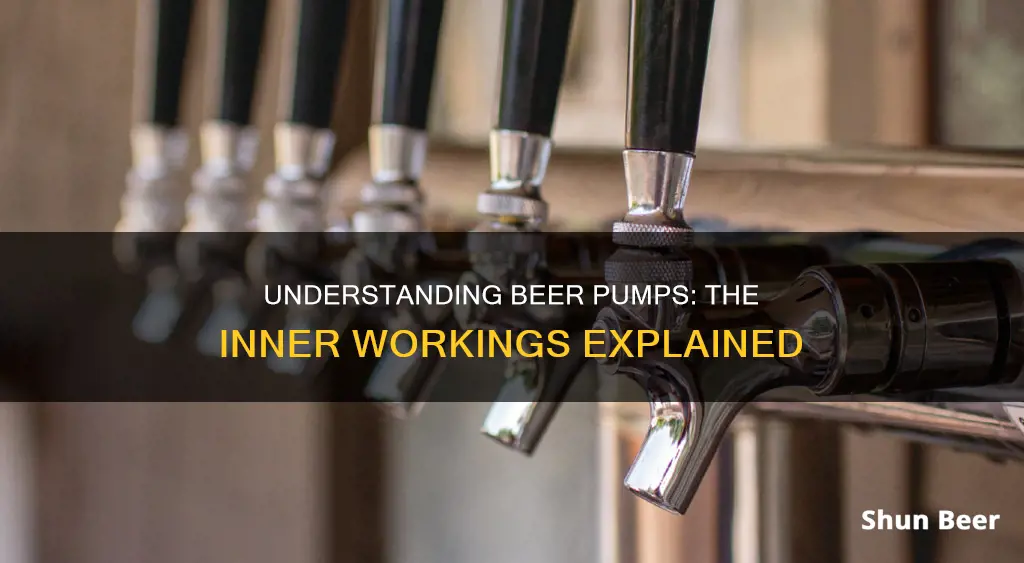
Beer pumps are an essential piece of equipment for any bar or brewery. They are used to move beer from a keg to a tap or faucet, making it faster and easier to serve pints than pouring by hand. The pump works by connecting to two different sources of pressure: carbon dioxide (CO2) pressure on the keg to maintain beer carbonation, and separate gas pressure running through the pump itself to propel the beer. The pump can be powered by CO2 or compressed air, with CO2 being the most common as it is usually already available at locations serving draught beer.
| Characteristics | Values |
|---|---|
| Purpose | To move beer from the keg to the faucet |
| Mechanism | Mechanical force or gas pressure |
| Suitability | Beer line systems requiring over 35-40 psi for consistent flow, runs over 200 feet, or significant vertical lift |
| Power Source | High-pressure gas or compressed air |
| Gas Type | CO2 or compressed air; nitrogen if using a beer pump |
| Pressure | CO2 pressure on the keg: 12-14 psi; separate gas pressure to the pump: 20+ psi |
| Portability | Portable versions available |
| Taste & Carbonation | Improved with a properly calibrated CO2 system |
| Maintenance & Cleaning | Easy with good-quality products |
What You'll Learn

Beer pumps use mechanical force to move beer from the keg to the faucet
A beer pump is an essential piece of equipment for any bar or brewery. Beer pumps use mechanical force to move beer from the keg to the faucet. This is an alternative to using gas pressure to move the beer. The pump works by connecting to two different sources of pressure.
Firstly, carbon dioxide (CO2) pressure is applied to the keg to maintain beer carbonation (12-14 psi). Secondly, separate gas pressure (20+ psi) runs through the pump itself to propel the beer to the faucet. The pump can be powered by either CO2 or dry compressed air. When the pump is turned on, it draws in beer from the keg and sends it through the line to the faucet. This allows for faster and more efficient service than pouring by hand.
Beer pumps are particularly useful in beer line systems where more than 35 or 40 psi is needed to create a consistent flow. They are often used for runs of more than 200 feet or setups that require a significant vertical lift. If gas pressure is used above these levels, it will alter the composition of the beer, affecting its taste and quality.
Most retailers opt to power their beer pumps with CO2. In these cases, the CO2 gas must be vented outside to avoid CO2 buildup and asphyxiation. Compressed air can also be used to power beer pumps, but it should never come into contact with the draught beer. It is best to use a high-quality air compressor to clean and dry the air and avoid damaging the pump.
Overall, beer pumps offer a fast, efficient, and reliable way to dispense beer, making them a valuable asset for any bar or brewery.
Germans' Morning Beer Workouts: Fact or Fiction?
You may want to see also

CO2 is used to maintain beer carbonation
Carbon dioxide (CO2) is a natural by-product of the beer-brewing process. During the fermentation stage, yeast breaks down the sugars from the beer wort into alcohol and CO2. This results in carbonation, which produces the bubbles and foam, or head, on top of a poured beer.
Secondary fermentation, or refermentation, involves adding a small amount of "priming sugar" to initiate another small fermentation process, creating additional carbon dioxide. This method is mostly used by home brewers and smaller brewing operations through a process called bottle conditioning.
Commercial beer production methods, on the other hand, introduce CO2 gas to achieve faster processing, more control, and consistent results. This is done through in-line carbonation, where CO2 is injected into flat beer as it's poured into a vessel, often the bright tank. Some gas injection methods combine nitrogen (N2) with CO2 or use N2 alone.
To maintain beer carbonation in draught systems, CO2 is used to help move the beer from the keg out of the tap. Using air compressors is not ideal as they introduce too much oxygen to the beer, significantly impacting its taste and quality.
The pump setup for a beer pump requires two operational regulator pressures. One is the CO2 pressure on the keg to maintain beer carbonation (12-14 psi), and the other is the separate gas pressure supplied to the beer pump (20+ psi) to propel the beer to the faucet.
Beer's Blood-Thinning Effect: Myth or Reality?
You may want to see also

Compressed air can also be used to power the pump
If compressed air is used, it should never come into contact with the draught beer. It is also important to use a high-quality air compressor to clean and dry the air to avoid damaging the beer pump. Smaller, cheaper air compressors often deliver air that still contains small amounts of moisture and oil that can cause damage to the pump over time.
CO2 is the most common gas used for dispensing beer as it is inexpensive and easy to obtain. However, if a beer pump is used to dispense the beer, nitrogen is required.
Krusteaz Buttermilk: The Perfect Beer Batter Base?
You may want to see also

Fixed and additive pressure pumps are the two basic types
Beer pumps are an essential piece of equipment for any bar or brewery. They are used to move beer from a keg or container to the faucet or tap, making serving beer a breeze. There are two basic types of beer pumps: fixed-pressure pumps and additive-pressure pumps.
Fixed-pressure pumps are becoming harder to find as they only deliver beer at the same pressure applied to the keg. On the other hand, additive-pressure pumps are commonly found in long-draw systems as the pressure applied to the keg is in addition to the gas pressure that moves the beer through the pump. This type of pump can still weakly pour beer even if it fails, which is something a fixed-pressure system cannot do.
The pump works by connecting to two different sources of pressure. Firstly, carbon dioxide (CO2) pressure is applied to the keg to maintain beer carbonation (12-14 psi). Secondly, separate gas pressure (20+ psi) runs through the pump itself to propel the beer to the faucet. The pump can be powered by either CO2 or dry compressed air, depending on your preference and availability.
When the pump is turned on, it draws beer from the keg and sends it through the line to the faucet, allowing for faster and more efficient service compared to manual pouring. This is especially useful for busy bars and breweries, enabling them to increase their output and keep up with orders during peak hours.
Beer Science: Brewing Basics and Beyond
You may want to see also

Beer pumps are essential for bars and breweries
Beer pumps are an essential component of any bar or brewery, playing a pivotal role in dispensing draft beer over long distances. They are a key part of the six main components of a draft system: cooler, keg, coupler, gas, tubing, and faucet.
Beer pumps ensure that beer is properly chilled and carbonated, with an appropriate foamy head. They are especially useful when beer needs to travel over long distances or up multiple floors, as they can maintain the integrity of the draft beer. This is achieved by using two operational regulator pressures: CO2 pressure on the keg to maintain beer carbonation, and separate gas pressure to propel the beer to the faucet.
The type of pump used depends on the specific brewing process and the characteristics of the liquid being pumped. Centrifugal pumps, for example, are commonly used in the industry due to their ability to handle large volumes of liquid quickly and their ease of cleaning and maintenance. On the other hand, positive displacement pumps are ideal for handling viscous liquids and liquids with high levels of solids, while peristaltic pumps are perfect for delicate liquids like yeast.
In addition to their functionality, beer pumps also have a symbolic value. The handle of a handpump is often used as a symbol of cask ale, representing the continued fermentation process and the use of spiles to control gas levels and achieve the optimal carbonation.
Furthermore, beer pumps offer versatility in serving options. For example, the side-pull taps are perfect for developing and showcasing the textural possibilities of lager, while the classic British beer styles and cask ales are making a comeback, offering a traditional and sessionable drinking experience.
Overall, beer pumps are essential for bars and breweries as they ensure the proper dispensing, carbonation, and temperature of draft beer, while also providing a range of serving options to cater to diverse customer preferences.
Beer Butt Chicken: Does It Work?
You may want to see also
Frequently asked questions
A beer pump is a device that uses compressed gas to push beer from a keg to the tap or faucet.
The pump works by connecting to two different sources of pressure: carbon dioxide (CO2) pressure on the keg to maintain beer carbonation (12-14 psi), and separate gas pressure (20+ psi) running through the pump itself to propel the beer. The pump can receive pressure from either CO2 or dry compressed air.
Using a beer pump can result in faster service, increased portability, improved taste and carbonation, and easy maintenance and cleaning.
First, prepare your equipment, including gas regulators, tubing/hoses, clamps/connectors, and an inline filter/strainer. Next, connect your gas source by attaching tubing to your regulator and then to your coupler/shank. Then, connect your output source by attaching tubing to the other side of the coupler/shank and to your taps. Finally, turn on your system and check for any signs of leakage.







